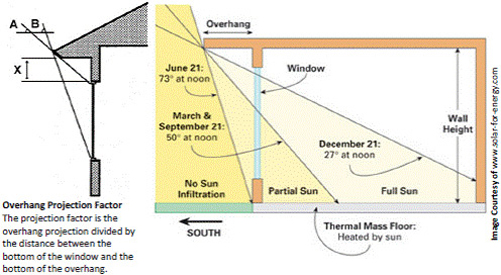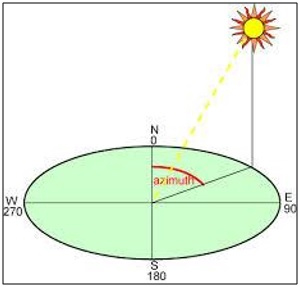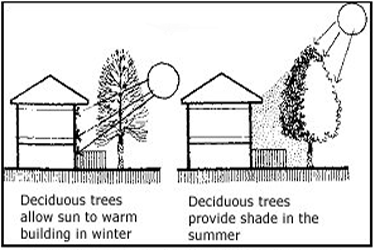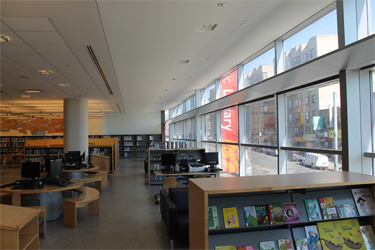Introduction
Within This Page
There are many different reasons to want to control the amount of sunlight that is admitted into a building. In warm, sunny climates excess solar gain may result in high cooling energy consumption; in cold and temperate climates winter sun entering south-facing windows can positively contribute to passive solar heating; and in nearly all climates controlling and diffusing natural illumination will improve daylighting.
Well-designed sun control and shading devices can dramatically reduce building peak heat gain and cooling requirements and improve the natural lighting quality of building interiors. Depending on the amount and location of fenestration, reductions in annual cooling energy consumption of 5% to 15% have been reported. Sun control and shading devices can also improve user visual comfort by controlling glare and reducing contrast ratios. This often leads to increased satisfaction and productivity. Shading devices offer the opportunity of differentiating one building facade from another. This can provide interest and human scale to an otherwise undistinguished design.
Description
The use of sun control and shading devices is an important aspect of many energy-efficient building design strategies. In particular, buildings that employ passive solar heating or daylighting often depend on well-designed sun control and shading devices.
During cooling seasons, external window shading is an excellent way to prevent unwanted solar heat gain from entering a conditioned space. Shading can be provided by natural landscaping or by building elements such as awnings, overhangs, and trellises. Some shading devices can also function as reflectors, called light shelves, which bounce natural light for daylighting deep into building interiors.
The design of effective shading devices will depend on the solar orientation of a particular building facade. For example, simple fixed overhangs are very effective at shading south-facing windows in the summer when sun angles are high. However, the same horizontal device is ineffective at blocking low afternoon sun from entering west-facing windows during peak heat gain periods in the summer.
Exterior shading devices are particularly effective in conjunction with clear glass facades. However, high-performance glazings are now available that have very low shading coefficients (SC). When specified, these new glass products reduce the need for exterior shading devices.
Thus, solar control and shading can be provided by a wide range of building components including:
- Landscape features such as mature trees or hedge rows;
- Exterior elements such as overhangs or vertical fins;
- Horizontal reflecting surfaces called light shelves;
- Low shading coefficient (SC) glass; and,
- Interior glare control devices such as Venetian blinds or adjustable louvers.

Aluminum architectural sun shade, horizontal sun control device, vertical fins
Fixed exterior shading devices such as overhangs are generally most practical for small commercial buildings. The optimal length of an overhang depends on the size of the window and the relative importance of heating and cooling in the building.
In the summer, peak sun angles occur at the solstice on June 21, but peak temperature and humidity are more likely to occur in August. Remember that an overhang sized to fully shade a south-facing window in August will also shade the window in April when some solar heat may be desirable.

Courtesy of SBIC and the Beyond Green™ Guidelines for High-Performance Homes
To properly design shading devices it is necessary to understand the position of the sun in the sky during the cooling season. The position of the sun is expressed in terms of altitude and azimuth angles.
- The altitude angle is the angle of the sun above the horizon, achieving its maximum on a given day at solar noon.
- The azimuth angle, also known as the bearing angle, is the angle of the sun's projection onto the ground plane relative to south.
- An easily accessed source of information on sun angles and solar path diagrams is Architectural Graphic Standards, 12th Edition, available from John Wiley & Sons, Inc. Publishers.

Azimuth angle See pveducation.org for more information.
Shading devices can have a dramatic impact on building appearance. This impact can be for the better or for the worse. The earlier in the design process that shading devices are considered they more likely they are to be attractive and well-integrated in the overall architecture of a project.
In ANSI/ASHRAE/IES Standard 90.1 Energy Efficient Design of New Buildings Except Low-Rise Residential Buildings (on which the Federal equivalent 10 C.F.R. § 435 is based), the degree of window shading is a major consideration. Both the projection factor (PF) for exterior shading and the shading coefficient (SC) of glass must be evaluated when using the Alternate Component Packages envelope design approach.
Designing Shading Systems
Given the wide variety of buildings and the range of climates in which they can be found, it is difficult to make sweeping generalizations about the design of shading devices. However, the following design recommendations generally hold true:
Use fixed overhangs on south-facing glass to control direct beam solar radiation. Indirect (diffuse) radiation should be controlled by other measures, such as low-e glazing.
To the greatest extent possible, limit the amount of east and west glass since it is harder to shade than south glass. Consider the use of landscaping to shade east and west exposures.
Do not worry about shading north-facing glass in the continental United States latitudes since it receives very little direct solar gain. In the tropics, disregard this rule-of-thumb since the north side of a building will receive more direct solar gain. Also, in the tropics consider shading the roof even if there are no skylights since the roof is a major source of transmitted solar gain into the building.
Remember that shading effects daylighting; consider both simultaneously. For example, a light shelf bounces natural light deeply into a room through high windows while shading lower windows.
Do not expect interior shading devices such as Venetian blinds or vertical louvers to reduce cooling loads since the solar gain has already been admitted into the work space. However, these interior devices do offer glare control and can contribute to visual acuity and visual comfort in the work place.
Study sun angles. An understanding of sun angles is critical to various aspects of design including determining basic building orientation, selecting shading devices, and placing Building Integrated Photovoltaic (BIPV) panels or solar collectors.
Carefully consider the durability of shading devices. Over time, operable shading devices can require a considerable amount of maintenance and repair.
When relying on landscape elements for shading, be sure to consider the cost of landscape maintenance and upkeep on life-cycle cost.
Shading strategies that work well at one latitude, may be completely inappropriate for other sites at different latitudes. Be careful when applying shading ideas from one project to another.


Examples of side landscape features that help to conserve energy For more information see: greenglobes.com
Curtain wall and a light shelf in a second-floor library space
Materials and Methods of Construction
In recent years, there has been a dramatic increase in the variety of shading devices and glazing available for use in buildings. A wide range of adjustable shading products is commercially available from canvas awnings to solar screens, roll-down blinds, shutters, and vertical louvers. While they often perform well, their practicality is limited by the need for manual or mechanical manipulation. Durability and maintenance issues are also a concern.
Require A&E professionals to fully specify all glass. They should be prepared to specify glass U-value, SC, and Tvis and net window U-value for all fenestration systems. The shading coefficient (SC) of a glazing indicates the amount of solar heat gain that is admitted into a building relative to a single-glazed reference glass. Thus, a lower shading coefficient means less solar heat gain. The visible transmittance (Tvis) of a glazing material indicates the percentage of the light available in the visible portion of the spectrum admitted into a building. See also WBDG Windows and Glazing.
When designing shading devices, carefully evaluate all operations and maintenance (O&M) and safety implications. In some locations, hazards such as nesting birds or earthquakes may reduce the viability of incorporating exterior shading devices in the design. The need to maintain and clean shading devices, particularly operable ones, must be factored into any life-cycle cost analysis of their use.
Application
Among the primary types of buildings that can benefit from the application of shading devices are:
- Barracks and other multi-family housing projects, especially in temperate or warm climates;
- Offices, administration buildings, and other structures employing daylighting; and,
- Nearly any structure in warm, sunny climates.
Relevant Codes and Standards
- Energy Policy Act of 2005
The WBDG Federal Facility Criteria is the source for the full text of all federal construction documents including Department of Defense Unified Facilities Guide Specifications (UFGS), Unified Facilities Criteria (UFC) and Federal Publications and Standards.
Additional Resources
Publications
- Low-E Glazing Design Guide by Johnson, Timothy E. Boston: Butterworth Architecture, 1991.—An excellent discussion of high-performance glazings and their specifications including shading coefficients.
- Simplified Design of HVAC Systems by Bobenhausen, William. New York: John Wiley & Sons, Inc., 1994.—An excellent source for information on the basics of solar geometry and sun angles.
- Solar Control and Shading Devices by Olgyay, Aladar and Olgyay, Victor. Princeton, New Jersey: Princeton University Press, 1957.—The classic source for information and examples of sun control and shading devices.
- Sun Protection: An International Survey by Danz, Ernst. New York: Frederick A. Praeger, 1967.—Out-of-print, but worth finding, it offers many provocative photographs and illustrations of shading devices from around the world.
Training Sessions
- Federal Energy Management Program (FEMP) offers a series of workshops on the use of renewable energy sources in federal buildings. This includes a segment on shading design. Contact FEMP for workshop dates and locations.
- Sustainable Buildings Industry Council (SBIC) offers Designing Low-Energy Building workshops that feature the use of ENERGY-10 software. These workshops include segment on shading design.
Design and Analysis Tools
There are a number of building analysis and design tools that permit users to evaluate the effect of different sun control and shading strategies.
- DOE 2—Description: Comprehensive hour-by-hour simulation; daylighting and glare calculations integrate with hourly energy simulation. IBM or compatible Pentium is advisable. Availability: Simulation Research Group, Lawrence Berkeley National Laboratory
- Radiance 3.5 (2003)—Description: A ray-tracing program that accurately predicts light levels and produces photo realistic images of architectural space in all sky conditions. Sun Microsystems, DEC, Macintosh with (AUX), CRAY or other UNIX machine. Availability: Environmental Energy Technologies Division, Lawrence Berkeley National Laboratory
- Energy Scheming (3.0)—Description: A Macintosh-based design tool rather than an analysis or evaluation tool. Only for Macintosh computers running OSX 6.x or earlier. Availability: Energy Studies in Buildings Laboratory (ESBL) Store University of Oregon
Others
- Tips for Daylighting with WindowsDownload ellen_thomas_lbnl-6902e.pdf
- Solar Energy Industries Association and SBIC include member firms that manufacture shading devices.










